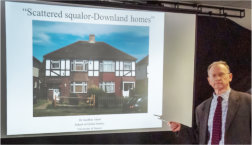 At the Spring in Havant on 7 March a full audience enjoyed an informative and well illustrated Day School, presented for the WEA by Geoffrey Mead on the topic of Aspects of Housing History. Beginning with early history, reference was made to the enclosures near Portsmouth, then the building of houses in the city, inhabited by the working class and cleared as slums in later years. Brighton’s approach to housing in the 19th century was totally different with the splendid Regency Square contrasted with the slaughterhouses in Paradise Street. The city had bad sanitation but the wealthy in Brighton had front gates to protect the large expensive houses of the rich.
At the Spring in Havant on 7 March a full audience enjoyed an informative and well illustrated Day School, presented for the WEA by Geoffrey Mead on the topic of Aspects of Housing History. Beginning with early history, reference was made to the enclosures near Portsmouth, then the building of houses in the city, inhabited by the working class and cleared as slums in later years. Brighton’s approach to housing in the 19th century was totally different with the splendid Regency Square contrasted with the slaughterhouses in Paradise Street. The city had bad sanitation but the wealthy in Brighton had front gates to protect the large expensive houses of the rich.
It was surprising to learn that in the 19th century even the middle classes did not aspire to living in the country, they preferred the urban spaces. However things changed when transport improved, more people could live in the country but commute to the city so ribbon development expanded even on to open downlands. These distinctive housing areas were known as “track and shack developments” many of which have now been destroyed.
Local materials such as flint and timber were used in building local houses, not shipped in from afar. Places like Dagenham developed huge estates and the occupants grew their own vegetables in their gardens. Unfortunately there was no real planning so again ribbon development flourished. After the 2nd World War housing was in short supply so one way to help solve housing problems was prefabs; instantly constructed homes with electric light, a bath and two bedrooms – bliss compared with just sharing a room.
Geoffrey concluded his very interesting talk by explaining that from the 1960s onwards people moved out from established urban spaces and new towns were created, including high- rise development.The urban landscape was changing.